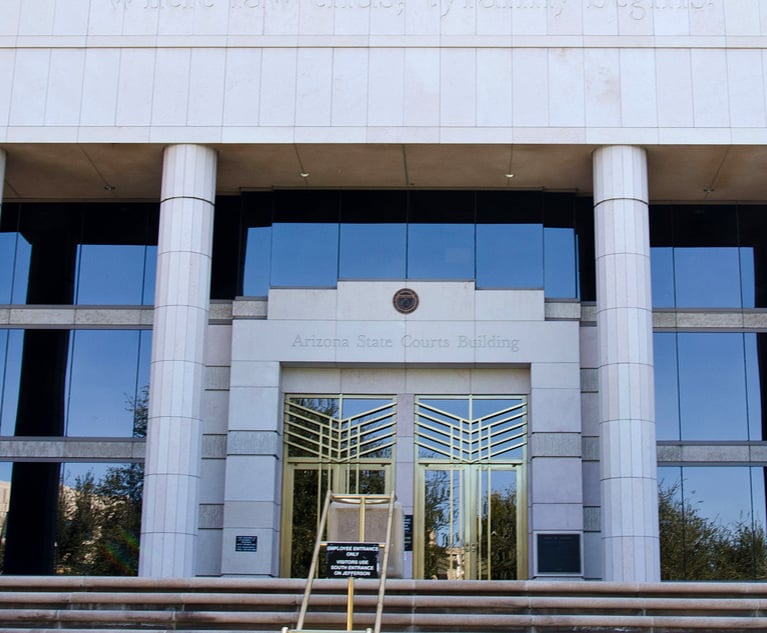Unstoppable? Latham & Watkins' march on the City shows no sign of abating
Latham & Watkins has arguably been more successful than any other non-native international firm in carving out a significant presence in both the City and Wall Street. But can it keep building on the momentum outside the US? Alex Newman finds out
December 03, 2014 at 07:25 PM
15 minute read
Latham & Watkins has arguably been more successful than any other non-native international firm in carving out a significant presence in both the City and Wall Street. But can it keep building on the momentum outside the US? Alex Newman finds out
"They're the guys that keep me up at night," one London-based Kirkland & Ellis partner recently confessed to Legal Week. He wasn't referring to the magic circle, any of the traditional New York thoroughbreds, his private equity clients or even Kirkland's take-no-prisoners management. "What's the latest on Latham, anyway?" he asked. It is a question that many will have asked themselves over the last few years.
In banking, capital markets and leveraged finance work, Latham & Watkins has performed exceptionally well in the City, bolstered by a string of high-profile lateral hires. It also has a stellar track record on the other side of the pond, securing a place near the top of Mergermarket's US M&A and buyout rankings on volume and value, acting on more high-yield bond issues than any other firm over the last five years and this year topping the US initial public offering (IPO) league tables.
But on the eve of long-serving chairman and managing partner Bob Dell's retirement, the firm still has a few questions of its own to answer. Chief among them: are its practice areas sufficiently balanced? How can it improve the profile of its non-core offices? And in London, what does it need to do to become full-service, given that even after a significant hiring spree it is – by the estimates of one senior Latham figure – "only 70-75% there"?
One practice that seems to have found some of the answers is the capital markets group. In the words of one partner in the practice: "There are a few investment banks that won't move forward on a deal unless they get Latham to approve it, even if they don't intend to instruct us."

In particular – and in keeping with the firm's front seat at the birth of the junk bond market in the eighties alongside client Drexel Burnham – high-yield remains a dominant force at Latham. In London the explosion of European and US debt capital markets work in the last two years has made the practice nothing short of a powerhouse.
"We always took the philosophy that we were going to spend time with everybody in the market," explains City practice head Richard Trobman, who was this year appointed to the firm's executive committee. "We're now probably the first call for the majority of banks, and if we're not first we're likely to be number two."
Those banks – including Credit Suisse, JP Morgan, Deutsche Bank, Goldman Sachs and Morgan Stanley – repeatedly turn to the team for a product that is not only high volume and high value but, for fragile corporates and their backers in recent times, high in demand. Speculation varies, but sources suggest the London high-yield group makes up between a third and a half of overall annual office revenues, which stood at around $210.6m (£134m) in 2013 – a single office figure not far behind that of top 25 UK firm Macfarlanes. One former partner says Trobman alone has a book of business worth more than $50m (£31.8m).
According to data from Mergermarket's debt arm, Xtract Research, Latham has advised on 25% of all high-yield offerings since the beginning of 2013, including 42%– 218 out of 514 – of European deals over the period, with a strong weighting to underwriter's counsel. In the last five years the firm has acted on more offerings than any other, on either side of the Atlantic.
As to concerns that market changes might bring to an end the high-yield gravy train, or tilt the legal market in favour of restructuring or litigation work, the feeling is that the group can cope with any new trends. Dell, as with the rest of the group, is bullish: "A good test of that was the financial crisis when it was anticipated that the demand for high yield would fall off dramatically, but the group remained extremely busy and found additional types of financing models to assist our clients."

Outside of high-yield, the City finance group works closely with its US colleagues to help make the market in other financing and debt products in Europe. "We also led the post-credit crisis development of both forms of European syndicated covenant lite, with first the New York law Chesapeake deal and then the Ceva Sante loan financing, which is the first English law cov-lite loan since the credit crunch," says banking co-head Chris Kandel.
Lagging behind though – at least compared to the debt group and the broader US capital markets team – is London's equity capital markets capabilities. "The London Stock Exchange premium listing has long been the province of the magic circle," comments Trobman. "While we recognise the competitive challenge, we are focused on increasing our share of premium-listing work and we will get there because it is core to our practice."
As it turns out, the firm has 'got there' before. "This was the case in New York 10 years ago," recalls capital markets co-chair Marc Jaffe. "We were pigeon-holed for our high-yield work, and now we're number one in the IPO rankings."
The corporate job
The firm's involvement in UK equity capital deals has already started to increase, with Latham catching mandates in this year's listing frenzy, including roles for the underwriters on the IPOs of Card Factory and RAC – the latter eventually canned in favour of a sale.
"There isn't a lot of public M&A in the UK, and I don't think any firm would have a magic strategy for building those routes, but we're finding ways," says private equity global co-chair David Walker. According to London-based executive committee member Mike Bond, recent efforts have included seconding partner Richard Butterwick to the Takeover Panel for two years, and the hires of former Clifford Chance (CC) partner Tim Page and Macfarlanes' Paul Davies, both of whom are experienced public M&A lawyers.
But in terms of balance, Latham is still a way off making the inroads in London that it has in the US, which accounts for the bulk of the firm's standing in the global deal rankings by volume and value. It is clear that Latham's global M&A chair Mark Gerstein wants to close this gap.
"In M&A we generally see two models: national firms with a dominant practice in London or New York, and firms with a large global offering but which have failed to establish leading M&A practices in their respective markets," he explains, arguing that Latham ticks the dominance and global boxes. "That strategy is the basis on which we will continue to build out our platform in London and other strategic M&A markets."
When it comes to private M&A, the firm has a better pedigree as a result of its strong ties to private equity groups. It strengthened these in London in 2013 with the arrival of Walker, another former CC man. "I may have courted my wife longer than we courted David, but it's probably close," says Gerstein.
For Walker, since leaving CC for Latham, the "overriding highlight has been the number of deals we've done and the breadth of our client base across Europe". These have included mandates for Charterhouse Partners, Onex, Hellman & Friedman, Cinven and Carlyle. Those relationships have also been earmarked as an important way into public companies, as buyout houses once again warm to portfolio company exits via the stock exchange.

Up for disputes
Another core focus for the firm is growing its New York and London 'controversy group' – Dell's collective phrase for the general disputes, antitrust, intellectual property and securities litigation practices, white collar and investigations teams. "It's around 30%," he says, referring to the group's revenue generation. "Historically it has been a little higher." Read: it should be higher now.
In London that average percentage is lower still. Office litigation chair Simon Bushell, who is helping to lead recruitment efforts, has in mind a figure of around 15 partners (up from nine) as part of a 50-strong group of controversy lawyers, as the optimum for London. "The firm has been focused on ensuring that the development of the practice is done in the right way," he adds. An energy disputes partner is close to signing and, across the group, the target is to build a global investigations and international arbitration bench.
Given its decent track record with lateral hires, the firm could well succeed. "[Office managing partner] Nick Cline is hiring smartly, and they've really worked hard at spotting any areas where they're deficient," comments one Latham client. "It's a real strength of the firm, and one area where I think they've been really successful in London."
Global issues
But for all its ability to attract talent and win work in its largest offices, outside the core financial centres Latham has arguably struggled more.
"One of the biggest challenges I found was the high fee rates," says one former partner based in the Middle East. "The firm has one global profit and loss statement, not individual office profit centres, which is great in terms of cohesion, cross-referral and financial transparency, but means there is not much rate flexibility across jurisdictions." Others suggest that in several markets – namely Asia, the Middle East and southern Europe – this inflexibility means the firm effectively prices itself out of some mid-market work.
"Latham needs to work out which side of the fence it's on," argues one client. "You can't straddle both, charging the high-margin rates you'd normally get in New York and London. As they expand to more markets and clients, they're going to have to get to grips with their fee model."
Dell defends the model, while acknowledging certain limitations to growth. "Clearly there are regions and clients where certain types of work come with expectations around rates. Our challenge is to find the right balance, and not to take on additional work just because we can add revenue." Some compromise is being struck, given the type of cutting-edge finance work found in London and New York is not abundant in all 32 offices.

But the fee habit can be found in core jurisdictions too. London partner rates are described by two former partners as typically "above magic circle", with several charging around £1,000 an hour, equity partners £750 and salaried/income partners – who make up around a third of the senior lawyer tier – in the £500-£700 bracket. Latham declined to comment on specific figures.
Current partners argue that, unlike the magic circle, their deals are leanly staffed and well-priced, but some former partners disagree. "I think it's the model," says one, pointing out that the firm asks for 4% annual rate increases. "Management doesn't allow partners to take a lot of liberty on discounts and I never got the sense that management was prepared to compromise, including on a 90% realisation rate target. But then you can't get profits that high without being expensive."
Average profit per equity partner – currently at $2.5m (£1.6m), rising to $4m (£2.5m) for partners at the top of the equity (and, according to one source close to management, $5.5m-$6m (£3.5m-£3.8m) for one or two partners) – is also achieved through a two-tier partnership, which Dell says the firm has "no desire" to change.
Comments from ex-partners that banking and corporate suffer from being top-heavy are dismissed by banking co-head Michele Penzer. "I disagree – just this month we promoted 19 new partners," she says. "You can't maintain a 40-year relationship with a leading financial institution without excellent succession planning."
"We have many lawyers in their thirties who are already clearly leaders of the future," adds Penzer's co-head, Kandel. "This is something I am very proud of."
At the other end of the scale, the firm is also confident that it can keep hold of the big-hitters, despite the knowledge that its modified lockstep may knock a few million off the potential pay cheques former partners such as David Zhang, Marc Hanrahan and Ron Hopkinson have been able to land at the likes of Kirkland, Milbank Tweed Hadley & McCloy and Cadwalader Wickersham & Taft respectively over the last six years.
Every rainmaker has their price, despite Latham's famous collegiality, but then you can't please everyone all of the time – be they demanding partners or general counsel on a tight budget.
To answer the original question posed by the Kirkland partner though – while there may be some fine-tuning needed, Latham is doing very well, thanks. And it looks likely to stay just as healthy under incoming chairman Bill Voge.
—————————————————————————————————————————
London hires since May 2013
David Walker, Kem Ihenacho and Tom Evans – Clifford Chance
Dean Naumowicz – Norton Rose
Lucy Oddy – Berwin Leighton Paisner
Simon Bushell – Herbert Smith Freehills
Tom Alabaster – The Carlyle Group
Paul Davies – Macfarlanes
Nick Benson – Weil Gotshal & Manges
Libby Savill – O'Melveny & Myers
—————————————————————————————————————————
Bob the builder – Latham's outgoing chairman on the firm he leaves after 20 years of growth
Bob Dell will wake up on New Year's Day without a job, just hours after leading Latham & Watkins to its strongest ever annual financial performance. Having handed leadership of the firm to chairman-elect Bill Voge in November, he is sanguine about life after Latham, his home since the originally West Coast outfit acquired the Chicago litigation boutique he worked at in 1982.
"I've got a pretty high level of anxiety about what it's going to be like," he jokes. "I'm not going to even think about it until 1 January; I've decided not to plan until I get the sense of what it is like not to be doing the job I've done for the past 20 years."
That job has taken the headquarter-less Latham from a 600-lawyer firm practising in 11 offices to more than 2,000 lawyers spread across 32 bases. Meanwhile, annual revenue has grown from $262m (£166.7m) to $2.3bn (£1.5bn), while profit per equity partner has climbed from $550,000 (£350,000) in 1994 to $2.5m (£1.6m) in 2013.
Does that now put Latham in the 'elite' bracket of global law firms? "I don't know if I understand exactly what is meant by the term 'global elite'," says Dell. "'Elite', in my mind, are those firms whose clients look to them for their most complicated work and value that work. That is the yardstick we measure ourselves by."
To those outside the firm, Latham is clearly in the elite, but without the historical weight and hang-ups of the City and Wall Street blue bloods. But whatever the branding, Dell feels his legacy matters little without the preservation of what he calls the firm's "most valuable asset".
"What I am most proud of is growing the firm without compromising its culture," he says. "It was articulated pretty clearly in the late sixties by Clint Stevenson [Latham's chairman from 1967 to 1988]; it involves collegiality, teamwork, transparency and meritocracy, and the vast majority of it hasn't changed much." Of particular importance to Dell is the firm's empowerment of its junior lawyers, its pro bono commitment and the careful way Latham goes about hiring laterals.
But other features of the firm certainly have been built under his watch. Seven years after Dell took the reins, and following a failed merger attempt with Ashurst, the firm decided to expand with a primary focus on Europe. "Markets like London and Germany were targeted as having significant growth opportunities," he reflects. "We still feel that London has a lot of exciting potential and it is probably at the top of the list of priorities."
New York has also been an enormous success story – one that may contain lessons for others. "For any firm, including the magic circle, to succeed in New York they need to convince clients that they can do the work," explains Dell. "One of the issues is attracting top talent. It's not just about financial resources and compensation, you have to convince talented partners that they are going to succeed on your platform."
Pressed on the next frontier for the firm – (Asia perhaps?) – Dell says Latham "[accepts] that there are some limitations to growth in every market… Our challenge is to find the right balance, and not to take on additional work just because we can add revenue."
Voge has previously said that he will simply try to continue Dell's work, and not reinvent the firm's strategy in favour of either revenue or geographic expansion. So what does Dell make of his successor? "I asked Bill to take the lead in the last executive committee meeting when we got together in person," he says. "He did a great job."
Related: Getting it right – why Latham & Watkins looks unstoppable in London
This content has been archived. It is available through our partners, LexisNexis® and Bloomberg Law.
To view this content, please continue to their sites.
Not a Lexis Subscriber?
Subscribe Now
Not a Bloomberg Law Subscriber?
Subscribe Now
NOT FOR REPRINT
© 2025 ALM Global, LLC, All Rights Reserved. Request academic re-use from www.copyright.com. All other uses, submit a request to [email protected]. For more information visit Asset & Logo Licensing.
You Might Like
View All
KPMG's Bid To Practice Law in US On Hold As Arizona Court Exercises Caution

Combative Arguments at EU's Highest Court Over Google's €4.13B Antitrust Fine Emphasize High Stakes and Invoke Trump
4 minute read
Law Firms 'Struggling' With Partner Pay Segmentation, as Top Rainmakers Bring In More Revenue
5 minute readTrending Stories
- 1The Lawyers Waging the Legal Fight Against the Trump Administration
- 2McDermott's Onetime London Leader Headed to Pillsbury
- 3A&O Shearman To Lose Another Five Lawyers to EY
- 4Pearl Cohen Enters San Francisco Market Via Combination With IP Boutique
- 5'Incredibly Complicated'? Antitrust Litigators Identify Pros and Cons of Proposed One Agency Act
Who Got The Work
J. Brugh Lower of Gibbons has entered an appearance for industrial equipment supplier Devco Corporation in a pending trademark infringement lawsuit. The suit, accusing the defendant of selling knock-off Graco products, was filed Dec. 18 in New Jersey District Court by Rivkin Radler on behalf of Graco Inc. and Graco Minnesota. The case, assigned to U.S. District Judge Zahid N. Quraishi, is 3:24-cv-11294, Graco Inc. et al v. Devco Corporation.
Who Got The Work
Rebecca Maller-Stein and Kent A. Yalowitz of Arnold & Porter Kaye Scholer have entered their appearances for Hanaco Venture Capital and its executives, Lior Prosor and David Frankel, in a pending securities lawsuit. The action, filed on Dec. 24 in New York Southern District Court by Zell, Aron & Co. on behalf of Goldeneye Advisors, accuses the defendants of negligently and fraudulently managing the plaintiff's $1 million investment. The case, assigned to U.S. District Judge Vernon S. Broderick, is 1:24-cv-09918, Goldeneye Advisors, LLC v. Hanaco Venture Capital, Ltd. et al.
Who Got The Work
Attorneys from A&O Shearman has stepped in as defense counsel for Toronto-Dominion Bank and other defendants in a pending securities class action. The suit, filed Dec. 11 in New York Southern District Court by Bleichmar Fonti & Auld, accuses the defendants of concealing the bank's 'pervasive' deficiencies in regards to its compliance with the Bank Secrecy Act and the quality of its anti-money laundering controls. The case, assigned to U.S. District Judge Arun Subramanian, is 1:24-cv-09445, Gonzalez v. The Toronto-Dominion Bank et al.
Who Got The Work
Crown Castle International, a Pennsylvania company providing shared communications infrastructure, has turned to Luke D. Wolf of Gordon Rees Scully Mansukhani to fend off a pending breach-of-contract lawsuit. The court action, filed Nov. 25 in Michigan Eastern District Court by Hooper Hathaway PC on behalf of The Town Residences LLC, accuses Crown Castle of failing to transfer approximately $30,000 in utility payments from T-Mobile in breach of a roof-top lease and assignment agreement. The case, assigned to U.S. District Judge Susan K. Declercq, is 2:24-cv-13131, The Town Residences LLC v. T-Mobile US, Inc. et al.
Who Got The Work
Wilfred P. Coronato and Daniel M. Schwartz of McCarter & English have stepped in as defense counsel to Electrolux Home Products Inc. in a pending product liability lawsuit. The court action, filed Nov. 26 in New York Eastern District Court by Poulos Lopiccolo PC and Nagel Rice LLP on behalf of David Stern, alleges that the defendant's refrigerators’ drawers and shelving repeatedly break and fall apart within months after purchase. The case, assigned to U.S. District Judge Joan M. Azrack, is 2:24-cv-08204, Stern v. Electrolux Home Products, Inc.
Featured Firms
Law Offices of Gary Martin Hays & Associates, P.C.
(470) 294-1674
Law Offices of Mark E. Salomone
(857) 444-6468
Smith & Hassler
(713) 739-1250









